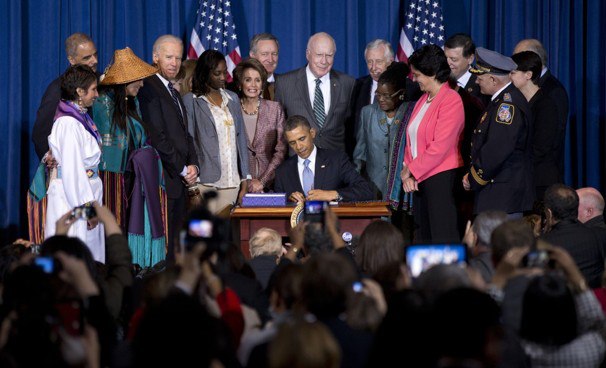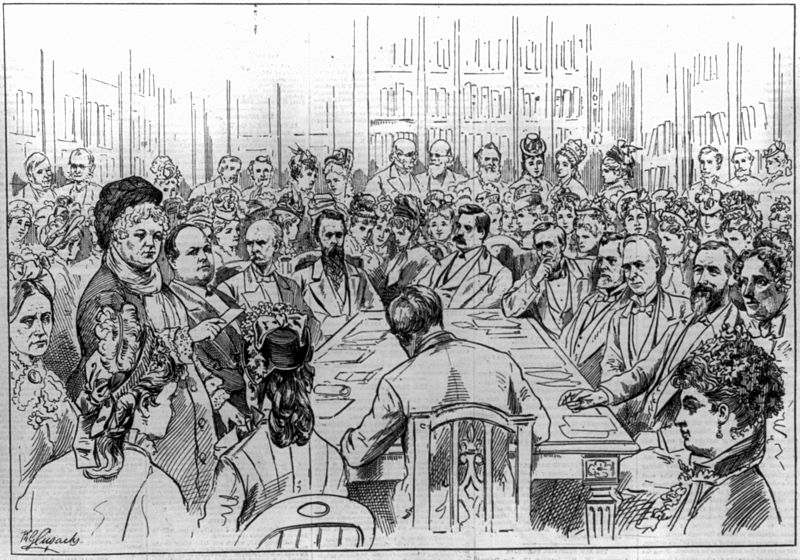Women secured the right to vote in the United States with the passage of the 19th Amendment 100 years ago this week. Since then, the country has seen a number of advances regarding the individual rights of women, even if some of those are inconsistently applied from state to state. Here are a dozen key moments in the work of women to level the playing field.
1. The 19th Amendment
Passed 100 years ago by the Senate on June 4, 1919, the 19th Amendment would enshrine the right of women the right to vote after being ratified by the states in 1920. It had been a long and difficult road, with an amendment introduced as early as 1878. While earlier efforts had stalled, World War I ended up pushing the process forward; with so many women serving the war effort in various capacities (including enlisting in the Marines), it was becoming progressively harder for anyone to find ways to deny women the right to vote. Organized suffragists pursued every strategy from marches to hunger strikes until president Woodrow Wilson was finally moved to support suffrage and call a special session of Congress. The bill passed the House on May 21 and the Senate on June 4; it was eventually ratified by the required number of states by August 18, 1920, and made official a week later on August 26.
2. The Equal Pay Act of 1963
Uploaded to YouTube by USDepartmentofLabor
The U.S. Government ran a campaign to encourage reports of Equal Pay law violations; this one featured Burt Ward and Yvonne Craig reprising their Batman roles, along with Adam West stand-in Dick Gautier, in 1973.
The Fair Labor Standards Act of 1938 instituted a right to minimum wage and codified the notion of “time-and-a-half” overtime. While it applied some new broad protections to workers, it didn’t quite cover everything. The 1949 Fair Labor Standards Amendment added protection to child workers while raising the minimum wage to 75 cents per hour, while the 1955 amendment extended coverage to service and retail workers left out of the original Act; it also raised the wage to 90 cents per hour. The Equal Pay Act built on these earlier protections, and forbade discrimination in wage rates “on the basis of sex.” While it did allow for pay disparity for businesses that had structures for earning higher pay built on merit or seniority, gender could not enter the compensation formula. One ironic aside is that the Act didn’t cover “white collar” or executive jobs, though the Education Amendments of 1972 closed that particular loophole.
3. LBJ’s 1967 Double Play
President Lyndon Johnson took part in the introduction of two rules that helped with pay and protections. Johnson’s Executive Order 11375 banned discrimination (again, “on the basis of sex”) for federal employment and government contractors. Public Law 90-130 enabled women in the military to be promoted equally, though the Combat Exclusion Policy would remain in effect until it was lifted in January 2013.
4. Title IX
Part of the broader Education Amendments of 1972, Title IX specifically states that “No person in the United States shall, on the basis of sex, be excluded from participation in, be denied the benefits of, or be subjected to discrimination under any education program or activity receiving federal financial assistance.” It covers any and all universities or private colleges that receive any kind of federal funding, including scholarships and financial aid; that means it effectively covers almost every institution of higher learning in the United States. Title IX is perhaps most frequently invoked in terms of athletics, as it states that women must have equal opportunity to play, though schools don’t necessarily have to offer the same sports to all genders (for example, you could have men’s football and women’s field hockey without being required to offer each to both genders). However, Title IX extends beyond athletics, covering housing, counseling, course offerings, and nearly every aspect of the educational experience offered by a college or university.
5. Roe v. Wade

The Supreme Court ruling on Roe v. Wade in 1973 applied the Due Process Clause of the 14th Amendment in determining that women have the “right to privacy” that protects a woman’s right to have an abortion. While deeply divided sentiments about the ruling remain, it’s still the law and is considered by many to be a fundamental element of women’s rights in America.
6. Pregnancy Discrimination Act of 1978
This act is one of several amendments that have been made to the Civil Rights Act of 1964. It specifically addresses Title VII of the Act to ensure protection of pregnant women. It prohibits employers from discriminating “on the basis of pregnancy, childbirth, or related medical conditions.” Another important dimension of the act is that it makes it clear that the same protections that apply to people with disabilities apply to pregnant women, as pregnancy is considering a temporary debilitating condition under a number of laws.
7. The Equal Rights Amendment
Passed by the House and Senate, but failing to receive ratification by the original deadline, the Equal Rights Amendment has remained a topic of discussion since attempts to introduce it in the 1920s. The amendment that made it through the process was re-introduced in 1971, and used the same text as a rewrite from 1943. Approved by the House and Senate by 1972, the amendment then went to the states. It passed 35 of the needed 38 states before it stalled, partially as a result of Phyllis Schlafly’s STOP ERA campaign. Today, there is still an effort to get the amendment ratified, even though the original deadline technically passed in 1982. Illinois became the most recent state to ratify the Amendment in May 2018.
8. The Family and Medical Leave Act of 1993
The FMLA was a major goal of president Bill Clinton. Just over a year after he took office, the Act was signed into law. Its major tenet is that employees can receive up to 12 unpaid weeks of leave for poor health, childbirth, adoption, or to care for a close relative. There are also previsions for families with service members, such as allowing leave to care for an injured service member in the family, or allowing service members themselves extended leave to deal with a qualifying injury. Employees get to keep their benefits during this time and there’s a built-in “right to return to a job,” with a couple of possible exceptions in terms of high-paying competitive fields.
9. Violence Against Women Act of 1994

The Violence Against Women Act was first passed as part of the Violent Crime Control and Law Enforcement Act as part of a broader effort to address sexual violence, domestic violence, and stalking. Due to the nature of appropriations, the Act has to be reauthorized; as such, it’s moved from a bipartisan effort to something of a political football. It was reauthorized in 2000, 2005, and 2012; it expired in December 2018 during the government shut-down, but received a temporary stay that lasted until February 2019. The House passed a reauthorization in April 2019, which now includes protections for transgender citizens, but the Senate has yet to take it up for a vote.
10. The Survivor’s Bill of Rights Act of 2016
Shocking as it may seem, statutory rights for survivors of sexual violence never existed in federal code prior to the authorization of this act. The law created a “bill of rights” for victims while at the same time updating the way that rape kits are processed. Among the enumerated rights are a survivor’s right to receive a no-cost forensic examination and to have the rape kit preserved for up to 20 years (or the “maximum applicable statute of limitations”). The Department of Justice is also compelled, as a result of the act, to make sure that survivors’ rights are communicated to everyone from health care providers to law enforcement agencies, as well as developing best practices to handle survivors’ cases.
Featured image: Elizabeth Cady Stanton addresses the Senate Committee on Privileges and Elections (Library of Congress)
Become a Saturday Evening Post member and enjoy unlimited access. Subscribe now




Comments
I believe all of these magazines should be in all Libraries. That is the place for all children & students to learn
what made this great country of ours and how men/women fought to keep it Free. We should thank all of
the people that built this country up to be the way it is, and through the Post Magazine you will learn all
you have to , to understand. Parents should have to have a Post in their homes for their children and them-
selves to read what they may have forgotten. take a chance and get the Post, Learn and Read. Know what
our Freedom is all about. God Bless Everyone